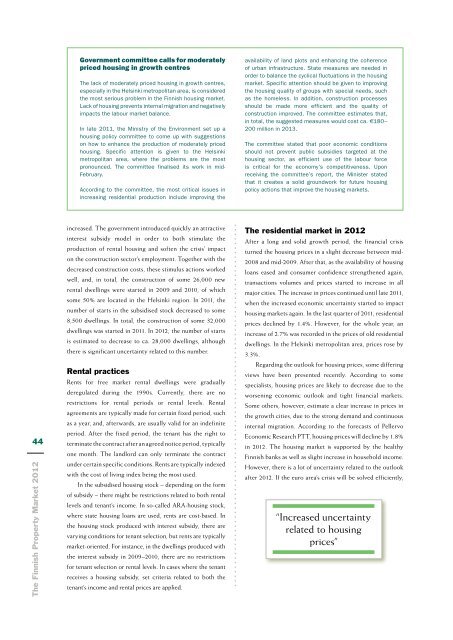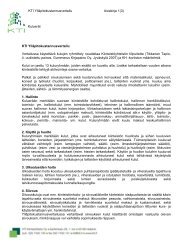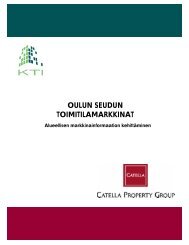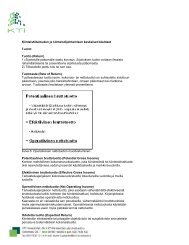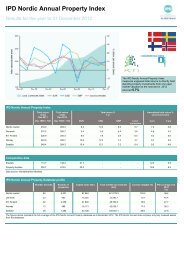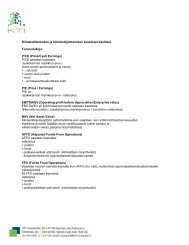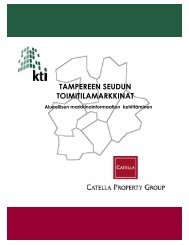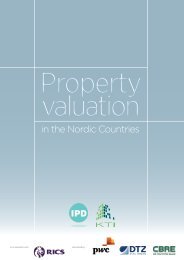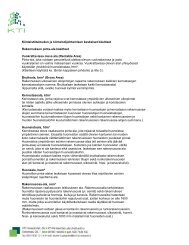The Finnish Property Market 2012 - KTI
The Finnish Property Market 2012 - KTI
The Finnish Property Market 2012 - KTI
You also want an ePaper? Increase the reach of your titles
YUMPU automatically turns print PDFs into web optimized ePapers that Google loves.
Government committee calls for moderately<br />
priced housing in growth centres<br />
<strong>The</strong> lack of moderately priced housing in growth centres,<br />
especially in the Helsinki metropolitan area, is considered<br />
the most serious problem in the <strong>Finnish</strong> housing market.<br />
Lack of housing prevents internal migration and negatively<br />
impacts the labour market balance.<br />
In late 2011, the Ministry of the Environment set up a<br />
housing policy committee to come up with suggestions<br />
on how to enhance the production of moderately priced<br />
housing. Specific attention is given to the Helsinki<br />
metropolitan area, where the problems are the most<br />
pronounced. <strong>The</strong> committee finalised its work in mid-<br />
February.<br />
According to the committee, the most critical issues in<br />
increasing residential production include improving the<br />
availability of land plots and enhancing the coherence<br />
of urban infrastructure. State measures are needed in<br />
order to balance the cyclical fluctuations in the housing<br />
market. Specific attention should be given to improving<br />
the housing quality of groups with special needs, such<br />
as the homeless. In addition, construction processes<br />
should be made more efficient and the quality of<br />
construction improved. <strong>The</strong> committee estimates that,<br />
in total, the suggested measures would cost ca. €180–<br />
200 million in 2013.<br />
<strong>The</strong> committee stated that poor economic conditions<br />
should not prevent public subsidies targeted at the<br />
housing sector, as efficient use of the labour force<br />
is critical for the economy’s competitiveness. Upon<br />
receiving the committee’s report, the Minister stated<br />
that it creates a solid groundwork for future housing<br />
policy actions that improve the housing markets.<br />
44<br />
<strong>The</strong> <strong>Finnish</strong> <strong>Property</strong> <strong>Market</strong> <strong>2012</strong><br />
increased. <strong>The</strong> government introduced quickly an attractive<br />
interest subsidy model in order to both stimulate the<br />
production of rental housing and soften the crisis’ impact<br />
on the construction sector’s employment. Together with the<br />
decreased construction costs, these stimulus actions worked<br />
well, and, in total, the construction of some 26,000 new<br />
rental dwellings were started in 2009 and 2010, of which<br />
some 50% are located in the Helsinki region. In 2011, the<br />
number of starts in the subsidised stock decreased to some<br />
8,500 dwellings. In total, the construction of some 32,000<br />
dwellings was started in 2011. In <strong>2012</strong>, the number of starts<br />
is estimated to decrease to ca. 28,000 dwellings, although<br />
there is significant uncertainty related to this number.<br />
Rental practices<br />
Rents for free market rental dwellings were gradually<br />
deregulated during the 1990s. Currently, there are no<br />
restrictions for rental periods or rental levels. Rental<br />
agreements are typically made for certain fixed period, such<br />
as a year, and, afterwards, are usually valid for an indefinite<br />
period. After the fixed period, the tenant has the right to<br />
terminate the contract after an agreed notice period, typically<br />
one month. <strong>The</strong> landlord can only terminate the contract<br />
under certain specific conditions. Rents are typically indexed<br />
with the cost of living index being the most used.<br />
In the subsidised housing stock – depending on the form<br />
of subsidy – there might be restrictions related to both rental<br />
levels and tenant’s income. In so-called ARA-housing stock,<br />
where state housing loans are used, rents are cost-based. In<br />
the housing stock produced with interest subsidy, there are<br />
varying conditions for tenant selection, but rents are typically<br />
market-oriented. For instance, in the dwellings produced with<br />
the interest subsidy in 2009–2010, there are no restrictions<br />
for tenant selection or rental levels. In cases where the tenant<br />
receives a housing subsidy, set criteria related to both the<br />
tenant’s income and rental prices are applied.<br />
<strong>The</strong> residential market in <strong>2012</strong><br />
After a long and solid growth period, the financial crisis<br />
turned the housing prices in a slight decrease between mid-<br />
2008 and mid-2009. After that, as the availability of housing<br />
loans eased and consumer confidence strengthened again,<br />
transactions volumes and prices started to increase in all<br />
major cities. <strong>The</strong> increase in prices continued until late 2011,<br />
when the increased economic uncertainty started to impact<br />
housing markets again. In the last quarter of 2011, residential<br />
prices declined by 1.4%. However, for the whole year, an<br />
increase of 2.7% was recorded in the prices of old residential<br />
dwellings. In the Helsinki metropolitan area, prices rose by<br />
3.3%.<br />
Regarding the outlook for housing prices, some differing<br />
views have been presented recently. According to some<br />
specialists, housing prices are likely to decrease due to the<br />
worsening economic outlook and tight financial markets.<br />
Some others, however, estimate a clear increase in prices in<br />
the growth cities, due to the strong demand and continuous<br />
internal migration. According to the forecasts of Pellervo<br />
Economic Research PTT, housing prices will decline by 1.8%<br />
in <strong>2012</strong>. <strong>The</strong> housing market is supported by the healthy<br />
<strong>Finnish</strong> banks as well as slight increase in household income.<br />
However, there is a lot of uncertainty related to the outlook<br />
after <strong>2012</strong>. If the euro area’s crisis will be solved efficiently,<br />
“Increased uncertainty<br />
related to housing<br />
prices”


